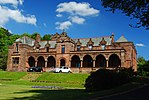Bennie Railplane
Experimental and prototype high-speed trainsExperimental locomotivesMilngavieRail transport in ScotlandRailway services introduced in 1930 ... and 1 more
Use British English from January 2017

The Bennie Railplane was a form of rail transport invented by George Bennie (1891–1957), which moved along an overhead rail by way of propellers.
Excerpt from the Wikipedia article Bennie Railplane (License: CC BY-SA 3.0, Authors, Images).Bennie Railplane
Bears Way,
Geographical coordinates (GPS) Address Nearby Places Show on map
Geographical coordinates (GPS)
| Latitude | Longitude |
|---|---|
| N 55.932 ° | E -4.3160277777778 ° |
Address
Bears Way
Bears Way
G61 3EE , Burnbrae
Scotland, United Kingdom
Open on Google Maps










